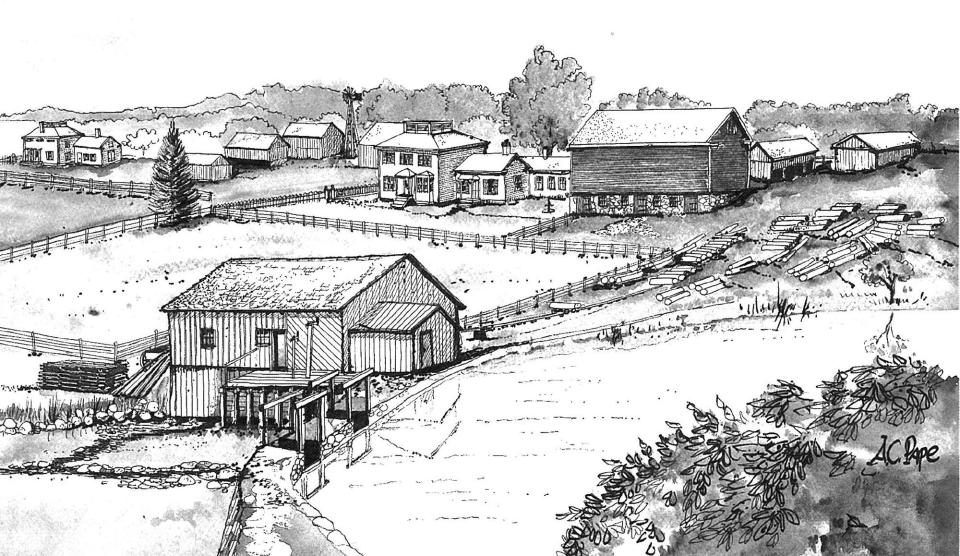Early Sheboygan County sawmill was reborn at Wade House thanks to Kohler Foundation | Throwback
GREENBUSH - Back in 1843, Thomas J. Townsend and a friend accidentally discovered the site for a sawmill while camping in the Wisconsin wilderness.
That camping spot happened to be where Greenbush would eventually develop as a community.
Townsend sold his claim to Sylvanus Wade, owner of the Wade House, who would then sell that claim to his son-in-law, Charles Robinson.
Robinson designed and built major properties in the village, including the Greenbush United Methodist Church, the Wade House and the Butternut House.
Robinson realized quickly that the Mullet River could support a sawmill operation. He built a mill in Greenbush, but in 1852 sold it to William Holloway. That mill would perish in a fire just a year later.
Sawmills were prone to starting on fire with sawdust and the heat created by sawing logs.
Holloway would rebuild the mill. It is thought that he grew tired of the effort of managing a sawmill operation and sold the facility in 1856 to German immigrant Theodore Herrling, who at the time was living in the Friendship township in Fond du Lac County. Herrling had experience as a sawyer in the kingdom of Saxony in Germany before immigrating to America.

Wisconsin at this time, including Sheboygan County, was mainly a wilderness covered in forests. Sawmills were in demand.
Early settlers fashioned log homes for shelter in those early days of Sheboygan County life. Many settlers yearned for something better, particularly if they had the money, according to the book, "The Promise of Prosperity: The story of Greenbush, Wisconsin and its water powered sawmill."
Moving to America was a major change for the Herrling family. They were a minority of Greenbush residents who spoke German, wore different style clothing and held different customs than their Anglo-Yankee neighbors. It took a long time for more Germans arrive in Greenbush. By 1860, only three families with German backgrounds resided in Greenbush.
According to information provided by the Sheboygan County Historical Research Center, it was known by many in Greenbush that Herrling had a troubled marriage to his wife Wilhelmina for quite some time, which resulted in an 1876 divorce. At the same time, the Mercantile Agency reported that Herrling had trouble with his wife and children. His ex-wife then left for Oregon with his two youngest children. She would die in Stayton, Oregon, in 1895. The Mercantile Agency is a system developed after the panic of 1837 to help inform others of information about customers' reliability and financial strength.
Herrling would operate the mill during the summer months when the water level permitted operations. He was busy with a small farming operation at the same time. The mill would close down in the winter because of icing problems.
His son, Rudolph Herrling, would take over the mill's operation, likely after his father's death at age 72 in 1885. The mill produced around 150,000 board feet of lumber worth around $1,000 in 1860, according to the Mercantile Agency.
The younger Herrling would operate the mill for many years until it was torn down sometime just before 1920. His son, Otto, would farm the 100-acre property for many years. In 1960, Otto, the grandson of immigrant Theodore Herrling would sell that farm. The sale, to the State of Wisconsin Conservation Department for $14,000, included the mill site and a 22-acre pond that was earmarked as future additional attractions at the Wade House Historic Site.
That land purchase was not long after the Kohler Foundation bought the Wade House and restored the house to its 1850s splendor. After the restoration, the foundation donated the Wade House to the State of Wisconsin as a historic site.
Eventually, plans were made to recreate the saw mill that was torn down in the 1920s with a near exact replica. The Kohler Foundation, along with the Wisconsin State Historical Society, provided the funding for the recreation and in the summer of 2001 the sounds of sawing wood could be heard once again where the mill was during the mid-19th century.
To see the image larger, click here.
RELATED - These early Sheboygan County cheesemakers helped propel Wisconsin cheese
RELATED - Sheboygan museum is home to this 1860s log cabin built by German immigrants
RELATED - Greenbush's Wade House | Throwback
This article originally appeared on Sheboygan Press: Wade House sawmill in Sheboygan County among few still in existence

